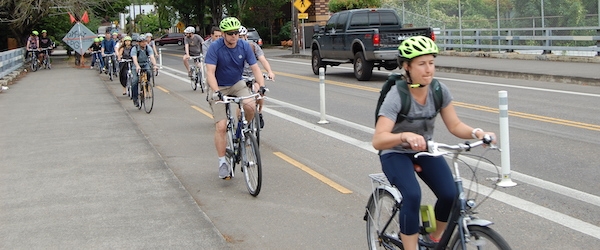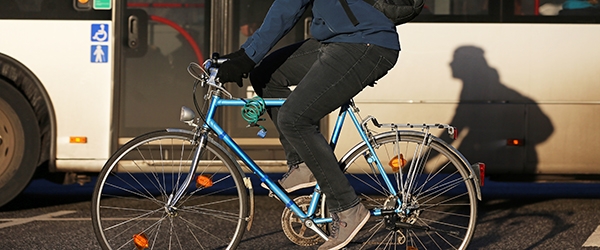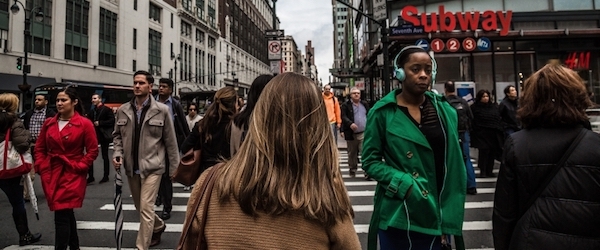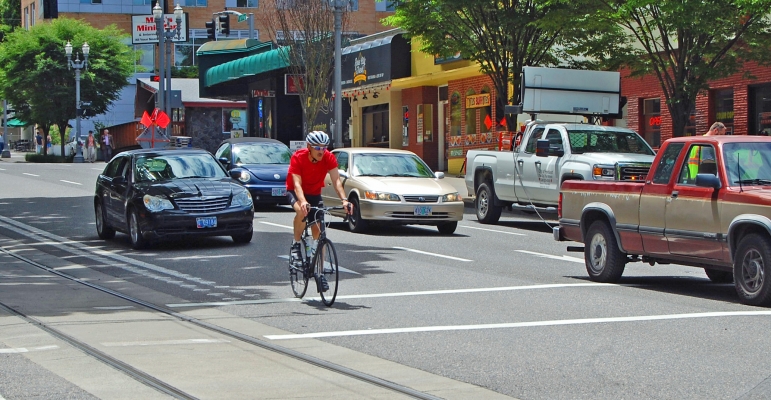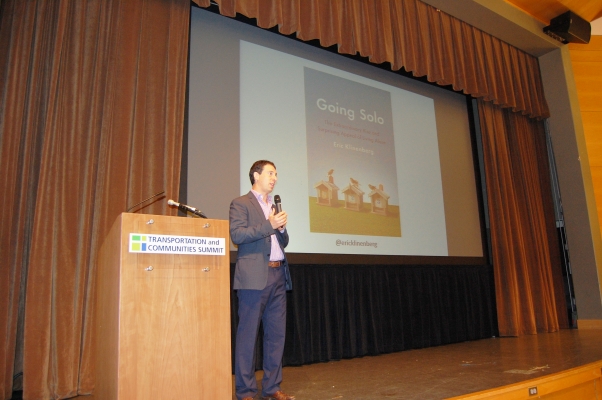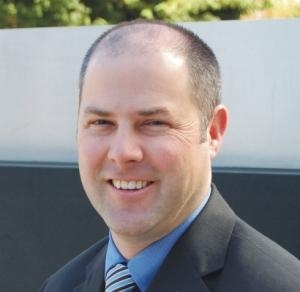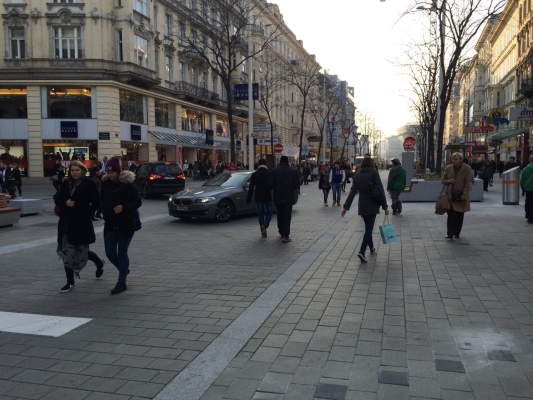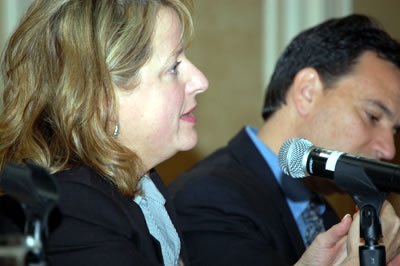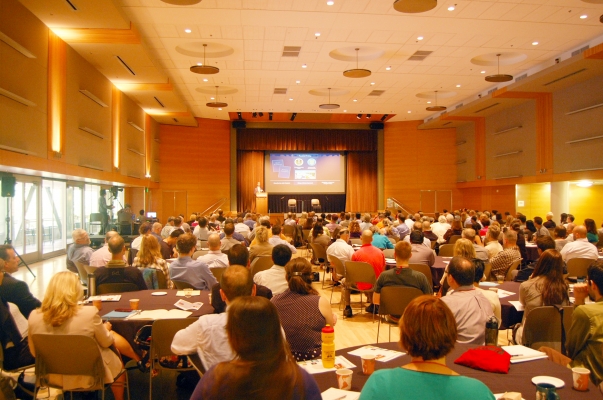In recent years, there have been over 600 bicyclist fatalities annually in the United States. This sobering statistic has motivated a number of recent studies, including the recently released National Transportation Safety Board study, “Bicyclist Safety on US Roadways: Crash Risks and Countermeasures (PDF). ” That report notes that midblock crashes account for a disproportionate number of bicyclist fatalities and severe crashes, and that separated on-street bicycle facilities may reduce the likelihood of these crashes. However, there are only limited data on the safety outcomes of separated on-street bikeways in the U.S., despite their increasing popularity...
Read more- Download the Poster Presentation for “Evaluation of Bus-Bicycle and Bus/Right-Turn Traffic Delays and Conflicts” (PDF)
When buses and bikes share space, it's complicated. Not only are there safety risks for cyclists, but also potential delays in bus service and stressful navigation for bus operators. The quest to increase bus speeds—and plausibly...
Read morePsychology teaches us that implicit biases—attitudes we hold on a level below consciousness, and may not even be aware of—can have a heavy influence on split-second decisions.
In a fast-paced activity like driving, with a lot of moving parts in a complex environment, we make those snap decisions all the time. There are obvious safety implications to this, particularly for the most vulnerable road users. That’s why TREC researchers are becoming more and more interested in studying implicit bias and social psychology as it relates to transportation behavior.
The latest report from the NITC program, Exploring Drivers’ Attitudes and Behaviors toward Bicyclists: The Effect of Explicit and Implicit Attitudes on Self-Reported Safety Behaviors, is a dissertation by NITC fellow Tara Goddard.
With a focus on driver-cyclist interactions, Goddard dives into the social psychology of roadway interactions and comes up with some interesting takeaways for practitioners and researchers. Before moving to Portland in 2011 to begin her Ph.D., Goddard was the bicycle/pedestrian coordinator for the City of Davis, California, and says that it’s important to understand the mechanisms at...
Read moreThe first Transportation and Communities Summit picked up where its predecessor summit left off, offering a day of professional development opportunities and a few new touches. Around 275 people attended this year’s summit, held Sept. 15 at Portland State University.
The highlight for many, according to post-event surveys, was the keynote address by author and sociology professor Eric Klinenberg. Keeping alive a tradition from earlier Oregon Transportation Summits, Klinenberg’s address gave insight into an issue that intersects with transportation—in this case, the rise of single-occupant households—without directly detailing the transportation implications.
The breakout sessions allowed attendees to delve deeper into topics directly related to their professions. A full 54 percent of survey respondents called the breakout sessions the most valuable piece of the summit program. The most highly rated sessions were “Waiting to Connect,” on connected vehicles; “Something from Nothing,” on funding; “Zeroing in on Safety,” on Vision Zero; and “Baby, You can Drive my Car;” on the sharing economy.
Slides from all these presentations are available at the summit page.
For the first time, summit sessions were Webcast for those who couldn’t attend in person...
Christopher Monsere, a civil and environmental engineering professor at Portland State University whose research focuses on multimodal safety, has been selected to be a member of Portland, Oregon's new Vision Zero Task Force.
Vision Zero is a multi-national safety project which aims to eliminate fatalities and serious injuries on the roads.
The Portland Bureau of Transportation, in an effort to make Portland's transportation system the safest possible, is taking steps to move toward zero traffic-related fatalities in the next 10 years.
To connect this work with a wider community effort, Mayor Charlie Hales kicked off the Vision Zero Task Force with a gathering last Monday, August 17, at the intersection of 82nd Avenue and Division—two of Portland’s most lethal corridors.
The Task Force is a multi-disciplinary and multi-jurisdictional group of members with a clear mandate: to work together and create a community-wide action plan with real solutions. Its members were chosen by Hales and Transportation Commissioner Steve Novick based on their qualifications and commitment.
Monsere will serve in an advisory capacity and investigate solutions as a TREC researcher. His expertise in the area of multimodal safety makes him uniquely qualified to offer...
Read moreTo be published later this spring is some of the first bicycle-focused research into shared space, a controversial urban design approach pioneered in the Netherlands in the 1990s.
Allison Duncan, a PhD candidate in urban studies & planning at Portland State University, earned a NITC dissertation fellowship in 2014 and used the research grant to study shared space intersections in the United Kingdom.
Shared space designs have recently been adopted at a handful of sites in the UK and others scattered across Europe, Australia and New Zealand. They are characterized by a lack of physical guidelines such as curbs, road surface markings and traffic signs to define who has the right-of-way.
The idea is for pedestrians, cars and bicycles to mingle in a common zone and use eye contact and natural communication to make sure no one gets hurt.
“Cyclists and pedestrians are supposed to be able to treat it more like a plaza and just cross where they want to, and drivers are supposed to yield,” Duncan said.
As a street design scheme, shared space isn’t exactly new. It’s more or less the way all streets were designed until the advent of cars, and is still the norm in many Asian countries where cars share the roads with a crowd of two- and three-wheeled...
Read more(First published by BikePortland.org)
Sue Groth’s job: use math and millions of dollars to stop injuries before they happen.
The team Groth leads at the Minnesota Department of Transportation has probably saved a few hundred lives over the last 10 years. In that time they’ve reinvented “highway safety” spending and seen traffic fatalities fall almost twice as fast as they have in Oregon and the rest of the country.
Groth is the plenary speaker at the Sept. 15 Oregon Transportation Summit hosted by OTREC at Portland State University. Michael Andersen of BikePortland spoke to her last week to talk about MnDOT’s daring decision to give up some of the “gobs of money” it gets for highway safety and hand it to local agencies instead.
What’s the nature of your work on the safety movement called Vision Zero, also known as Toward Zero Deaths?
My state happened to be one of the first to adopt it. We have had a program for over 10 years now and have had some pretty good success. We don’t have to accept the fact that 400 people a year die on the roads in Minnesota, or 33,000 nationally.
400?
Oh, I’d better give you a precise number: 387. Minnesota’s had great success. One year we actually got down to 368.
(Editor’s note:...
Read more- An analysis of the effects of commuter rail on population deconcentration.
- A look into prioritizing pedestrians at signalized intersections.
- A study of cyclist-vehicle interaction.
- An evaluation of an eco-driving intervention.
What is the highest number of deaths and serious injuries we should accept from our transportation system? For transportation agencies who have long sought to reduce traffic fatalities, a movement to eliminate them completely has gained currency.
This year’s Oregon Transportation Summit brings a strong safety theme, including plenary session and morning and afternoon workshops. Registration for the summit officially opens today.
Register or learn more about the summit, which takes place Monday, Sept. 15.
The 2014 Oregon Transportation Summit opens with a plenary session titled “Envisioning Vision Zero.” Vision Zero is the approach, initiated in Sweden, to not accept deaths or serious injuries as a tradeoff for other goals of the road network. In the United States, a national effort called Toward Zero Deaths grew out of these principles.
Minnesota Toward Zero Deaths has been a leader among state programs, working with partners across jurisdictions and service categories across the state to address roadway deaths and injuries. Sue Groth oversees this effort as the state traffic engineer and director of the Office of Traffic, Safety and Technology for the...
Read more
